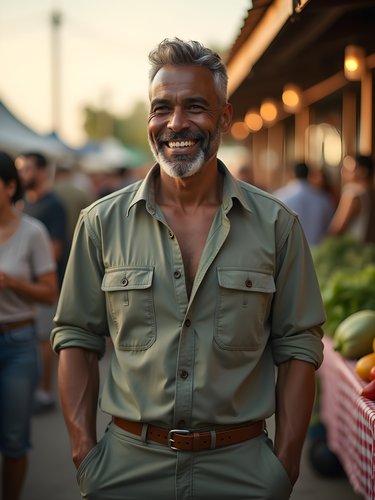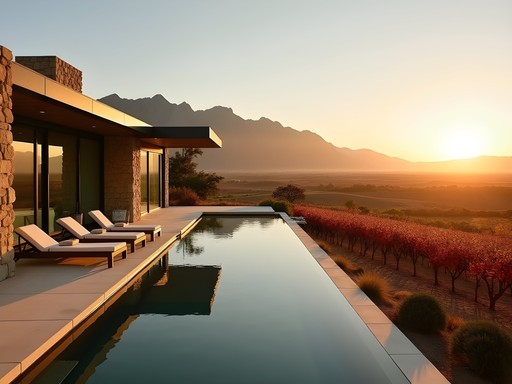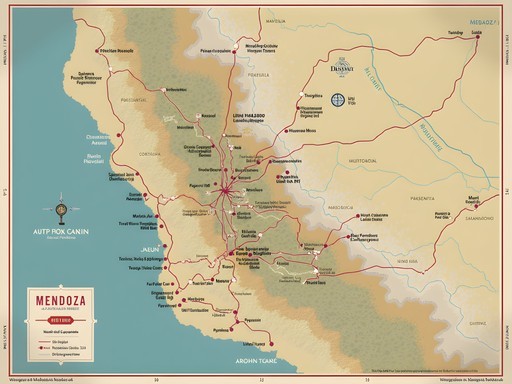Disclosure: This article contains affiliate links. We may earn a commission from purchases at no extra cost to you, which helps our travel content.
I've traveled to over 40 countries during my career as a fitness consultant, but few destinations have captivated me like Mendoza. This Argentine wine region sits in the shadow of the majestic Andes Mountains, creating a backdrop that makes every glass of Malbec taste even more spectacular. As someone who appreciates the balance between indulgence and wellness, Mendoza offers the perfect formula: world-class wines, farm-fresh cuisine, and outdoor activities that keep you moving between tastings. Last fall, I took a week-long luxury wine tour through Mendoza that transformed my appreciation for Argentine wine culture. Whether you're a seasoned oenophile or simply enjoy the occasional glass with dinner, this Andean wine paradise delivers an experience that engages all your senses – from the first sip to the last sunset.
Planning Your Mendoza Wine Adventure
Mendoza's wine country spans three primary regions: Luján de Cuyo, Uco Valley, and Maipú, each offering distinct terroir and wine experiences. After consulting with several wine-loving clients who'd visited before, I structured my trip around these areas, dedicating at least one full day to each.
Fall (March through May) is harvest season – or vendimia – making it the ideal time to visit. The weather is perfectly temperate, hovering between 60-75°F (15-24°C), with minimal rainfall and spectacularly clear mountain views. The vineyards explode with autumn colors while the wineries buzz with harvest activity.
For accommodations, I recommend splitting your stay between Mendoza city and one of the wine regions. I spent three nights at The Vines Resort & Spa in Uco Valley, which offers luxury villas nestled among the vineyards. The remaining nights were at Park Hyatt Mendoza, providing easy access to the city's restaurants and nightlife.
Transportation requires planning since vineyards are spread across considerable distances. While some travelers rent cars, I strongly advise against this option if you're planning serious wine tasting. Instead, I booked a private driver through Mendoza Wine Camp, which proved invaluable. My driver, Eduardo, not only navigated the sometimes confusing roads but also served as an impromptu guide, sharing local insights I wouldn't have discovered otherwise.
Before arriving, I found tremendous value in a comprehensive wine journal to document tasting notes. By trip's end, this became a treasured souvenir filled with memories and newfound wine knowledge.

💡 Pro Tips
- Book winery visits at least 2-3 weeks in advance, especially for high-end producers
- Consider hiring a private driver rather than renting a car – safety first when wine tasting
- Pack layers for fall visits – mornings and evenings can be quite cool despite warm afternoons
Luján de Cuyo: The Malbec Heartland
Luján de Cuyo, often called the 'Primera Zona' or first zone of Mendoza wine country, sits at elevations between 3,000-3,600 feet and is widely considered the birthplace of Argentine Malbec. The high altitude, intense sunlight, and cool nights create perfect conditions for developing the deep color, intense fruit flavors, and velvety texture that make these wines world-famous.
My first stop was Catena Zapata, whose striking Mayan-pyramid-inspired winery is as impressive as their wines. Founded in 1902, this pioneering family estate helped put Argentine Malbec on the global map. Their high-altitude vineyard tour was particularly fascinating – I've always appreciated how elevation affects athletic performance, and here I learned how it similarly impacts grape development. The tasting included their iconic Adrianna Vineyard Malbec, which showcases the elegant, mineral-driven style possible at extreme elevations.
Next was Achaval-Ferrer, a boutique producer known for small-production, single-vineyard Malbecs. What struck me here was the focus on old vines – some over 100 years old – producing incredibly concentrated fruit. Their minimalist winemaking approach lets the terroir speak clearly through each wine. The intimate tasting experience here contrasted beautifully with larger operations.
For lunch, I visited Bodega Norton for their exceptional seven-course tasting menu paired with reserve wines. The standout was their grilled provoleta cheese with chimichurri followed by a perfectly prepared grass-fed ribeye steak. As someone who carefully considers nutrition, I appreciated how the chef highlighted local, seasonal ingredients while explaining how each dish complemented specific wine characteristics.
Between tastings, I found my insulated water bottle indispensable. Staying hydrated is crucial when wine tasting at high altitude – something my fitness background has taught me well. The bottle kept water cold throughout the day and helped maintain balance between wine samples.

💡 Pro Tips
- Schedule no more than 3 wineries per day to avoid palate fatigue
- Always taste Malbec alongside other varietals like Cabernet Franc and Bonarda for comparison
- Ask about vineyard elevation – it dramatically affects wine characteristics in Mendoza
Uco Valley: The New Frontier of Argentine Wine
An hour's drive south of Mendoza city lies the Uco Valley, where vineyards climb even higher up the Andean foothills – some reaching over 5,000 feet above sea level. This remote region represents the cutting edge of Argentine winemaking, with cooler temperatures producing wines of remarkable freshness and complexity.
My day began at Clos de los Siete, a collaborative project between seven French winemakers including the legendary Michel Rolland. The property spans 2,100 acres, with each producer maintaining distinct vineyard plots while contributing to a remarkable collaborative blend. What impressed me most was their gravity-flow winery design – similar to how I structure fitness routines to work with the body's natural mechanics rather than against them.
The architectural highlight of my Uco Valley exploration was undoubtedly Bodega Salentein. Their underground barrel room resembles a modern cathedral, with three wings extending like a cross, designed for both optimal wine aging and acoustic perfection. During my visit, they were hosting a small chamber music performance among the barrels – the convergence of wine, architecture, and music created a multisensory experience I won't soon forget.
For an unforgettable lunch experience, I visited Andeluna for their six-course chef's table experience. Seated with a panoramic view of the vineyards and mountains through floor-to-ceiling windows, each course featured hyperlocal ingredients paired with limited production wines. The slow-cooked lamb with native herbs and roasted Andean potatoes paired with their Altitud Cabernet Franc was a revelation.
During my Uco Valley explorations, I found myself constantly reaching for my compact binoculars to observe distant vineyard operations and wildlife. The region hosts remarkable biodiversity, and between tastings, I spotted several Andean condors soaring above the mountains – a magnificent sight that added another dimension to the wine experience.

💡 Pro Tips
- Allow extra travel time between Uco Valley wineries as distances can be deceptive
- Make lunch reservations at winery restaurants well in advance – they often sell out
- Bring a light jacket even on warm days as temperatures can drop quickly with elevation changes
Beyond Wine: Mendoza's Culinary Scene
While wine might be Mendoza's headline act, the supporting culinary scene deserves equal billing. The region's food philosophy mirrors what I advocate in my fitness practice – quality ingredients, thoughtful preparation, and celebration of natural flavors.
Mendoza's cuisine revolves around Argentina's famed beef, but with regional twists that showcase local produce. At Siete Fuegos (Seven Fires) in the Vines Resort, I experienced Francis Mallmann's legendary open-flame cooking techniques. The seven different fire-cooking methods – from parrilla grill to clay oven – created dishes with remarkable depth and character. The slow-grilled rib eye with chimichurri was transcendent, especially paired with a reserve Malbec from the property's vineyards.
In Mendoza city, Azafrán Restaurant offered a more contemporary dining experience. Their farm-to-table approach and wine cellar with over 700 labels allows diners to personally select bottles with the sommelier's guidance. Their trout with Andean herbs and quinoa risotto showcased regional ingredients beyond the expected beef focus.
For a more casual but equally authentic experience, I visited Mercado Central, where locals shop for fresh produce, meats, and prepared foods. Following my philosophy that understanding food sources connects us more deeply to what we consume, I spent a morning exploring the market stalls, sampling regional cheeses, olives, and dulce de leche treats.
One unexpected culinary highlight was an empanada cooking class at Finca Agostino winery. Our instructor, Maria, demonstrated seven regional empanada styles while explaining how each province developed distinct folding techniques and fillings. This hands-on experience provided cultural insights I couldn't have gained through restaurant dining alone.
For capturing these culinary moments, my smartphone tripod proved invaluable. As a solo traveler documenting my journey, this compact tool allowed me to capture both food photos and selfies with chefs and winemakers without awkwardly asking strangers for help.

💡 Pro Tips
- Order beef medium-rare (jugoso) rather than well-done to experience Argentine beef at its best
- Try local specialties beyond beef – Mendocino river trout and kid goat are regional specialties
- Book a cooking class that includes market shopping for a deeper understanding of local ingredients
Outdoor Adventures Between Tastings
As a fitness professional, I can't visit any destination without seeking opportunities for movement and outdoor activity – even on a wine-focused trip. Fortunately, Mendoza offers plenty of options to balance indulgence with activity.
The Andes provide a spectacular backdrop for outdoor adventures, and many visitors don't realize how accessible mountain excursions are from wine country. I dedicated one full day to exploring Aconcagua Provincial Park, home to the highest peak in the Americas. While summiting Aconcagua requires serious mountaineering skills and permits, day hikes offer accessible views of this 22,841-foot giant. The Horcones Lagoon trail (about 4 miles round-trip) provided spectacular vistas without requiring technical skills.
For a unique perspective on the vineyards, I booked an early morning hot air balloon ride over Luján de Cuyo. Drifting silently above the patchwork of vineyards as the sun illuminated the Andes was meditative and offered a deeper appreciation for the region's geography. The post-flight champagne breakfast felt well-earned after the 4:30am wake-up call.
Mendoza's extensive irrigation system, dating back to pre-Columbian times, created tree-lined canals throughout the city that now serve as excellent running routes. As someone who believes in maintaining fitness routines while traveling, I appreciated these shaded paths for morning runs before the day's wine activities began.
Perhaps most memorable was horseback riding through the vineyards with Cabalgatas Mendoza. My guide, a third-generation gaucho named Diego, shared stories of growing up on Mendocino estancias while leading us through vineyard trails and up into the foothills for panoramic views. The ride concluded with a traditional asado lunch prepared by Diego's family – proving once again that physical activity enhances culinary experiences.
For these outdoor adventures, my hiking daypack was perfect for carrying water, layers, and camera gear while maintaining comfort during various activities. Its compact size meant I could keep it in the car during winery visits, ready whenever an opportunity for exploration arose.

💡 Pro Tips
- Schedule outdoor activities in the morning before afternoon wine tastings
- Book mountain excursions with extra time to acclimate to altitude changes
- Pack proper footwear – vineyard walks often involve uneven terrain
Final Thoughts
Mendoza delivers a rare balance that resonates deeply with my philosophy on life – indulgence tempered with activity, tradition harmonized with innovation. The region's Malbecs deserve their global reputation, but it's the complete experience – the Andean backdrop, the passionate producers, the farm-fresh cuisine, and the outdoor adventures – that makes Mendoza truly exceptional. As I boarded my flight home, my luggage considerably heavier with carefully wrapped wine bottles, I reflected on how this region had reshaped my understanding of Argentine culture through its wines. Whether you're celebrating a special occasion or simply seeking a deeper connection to one of the world's great wine regions, Mendoza rewards visitors with experiences that engage all senses. The memories of snow-capped peaks viewed through ruby-red Malbec, and conversations with multi-generation winemaking families, will linger long after the last bottle from your trip has been enjoyed. ¡Salud!
✨ Key Takeaways
- Fall (March-May) offers the perfect combination of harvest activity, ideal weather, and stunning autumn colors in the vineyards
- Balance winery visits between established producers in Luján de Cuyo and innovative newcomers in Uco Valley
- Hire a driver rather than self-driving to fully enjoy the wine experience safely
- Make time for outdoor activities that showcase Mendoza's spectacular natural setting
📋 Practical Information
Best Time to Visit
Fall (March-May)
Budget Estimate
$400-600 per day for luxury accommodations, private tours, and fine dining
Recommended Duration
5-7 days
Difficulty Level
Easy
















Comments
Lillian Diaz
Aiden, your post captures the essence of Mendoza perfectly! I backpacked through Argentina last year and spent a week in wine country. For anyone planning a trip - don't miss Bodega Salentein in Uco Valley. Their art gallery and underground cellar are incredible, and the tasting experience was worth every peso. Also, if you're into more than just wine, I did a cooking class in Mendoza city where we learned to make traditional Argentine dishes. The chef took us to the local market first to select ingredients, and it was such an immersive cultural experience. The empanadas we made paired perfectly with the local Malbec! One tip: many wineries require reservations, especially the smaller boutique ones, so plan ahead if you have specific places in mind.
nomadbuddy
Any recommendations for wineries that are more budget-friendly but still offer good tastings? Also, is it possible to enjoy Mendoza if you only have 2-3 days?
Lillian Diaz
Not Aiden, but I was there last year! For budget options, try Bodega La Azul and Pulenta Estate - both had reasonable tasting fees and didn't require reservations when I visited. And yes, 2-3 days is tight but doable! I'd suggest one day in Luján de Cuyo (closer to the city) and one day in Uco Valley. Skip the city tours and focus on the wine regions. The local buses can get you to some wineries if you're really budget-conscious, but sharing a tour with other travelers is more efficient time-wise.
nomadbuddy
Thanks Lillian! That's super helpful. Did you find English was widely spoken or should I brush up on my Spanish?
Lillian Diaz
At the wineries that cater to tourists, English was no problem. But having basic Spanish phrases definitely helped with transportation and in restaurants off the tourist path. Even just simple greetings and numbers go a long way!
summerlife
OMG I'm literally booking flights to Argentina after reading this!!! Those food pics have me DROOLING and I need that Malbec in my life ASAP! 🍷✈️
Marco Flores
Aiden, your post brought back amazing memories! I was in Mendoza last year and completely fell in love with Uco Valley. The combination of those dramatic mountain views and innovative winemaking was incredible. We stayed at a small posada run by a local family who taught us how to make traditional empanadas - the perfect pairing with Malbec! Did you get a chance to try horseback riding through the vineyards? That was definitely a highlight for me - seeing the landscape from that perspective while the sun was setting behind the Andes was unforgettable. I used my wine travel journal to document all the tastings - helped me remember which wines I wanted to bring home!
summerlife
Marco - which posada did you stay at? Planning a trip for January and looking for recommendations!
Marco Flores
It was Posada del Vino in Uco Valley - family-run, incredible homemade breakfasts and they helped arrange all our winery visits. Not luxury but authentic and charming!
photohero
That sunset shot over the vineyards with the Andes in the background is absolutely stunning! What camera setup are you using these days?
winteradventurer
Great post! How did you get around between the wineries? Did you hire a driver or join a tour? Trying to plan my visit for next spring.
Aiden Gordon
I hired a local driver for the day in Luján de Cuyo - definitely worth it so everyone could enjoy the tastings! In Uco Valley I joined a small group tour since the distances are greater. Both worked great!
winteradventurer
Thanks for the quick response! Did you book the driver in advance or when you arrived?
Aiden Gordon
I booked about 2 weeks ahead through my hotel. If you're going during high season (Oct-Apr), I'd definitely recommend arranging it in advance!
beachnomad
Mendoza has been on my bucket list forever! Those Malbecs look amazing.
CuisineCrazy
Don't miss the empanadas at Bodega Ruca Malen! Their six-course lunch with wine pairings was the highlight of our trip. Make reservations at least a week ahead.
wine_loving_wanderer
Great post! How's the weather in February? Thinking about planning a trip then.
ArgentinaFan
February is harvest season! Hot during the day (85-95°F) but it cools down at night. Some wineries have harvest festivals if you time it right. Just book accommodations early - it gets busy.
wine_loving_wanderer
Harvest season sounds perfect! Thanks for the tip about booking early!
mountain_hiker22
Those Andes views are incredible! Adding Mendoza to my bucket list ASAP.
Venture X
Premium card with 2X miles, $300 travel credit, Priority Pass